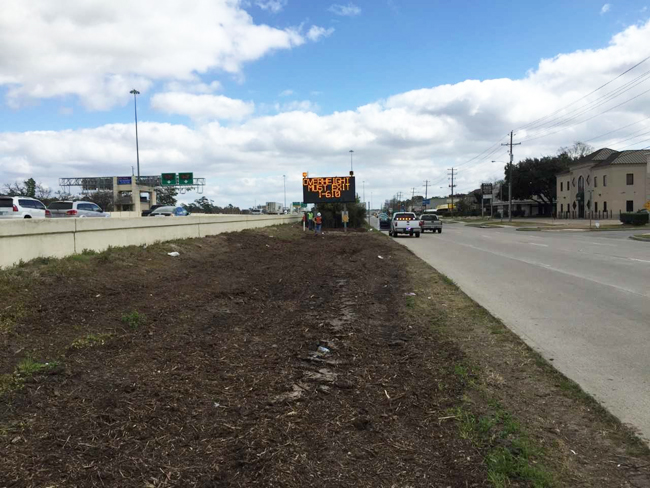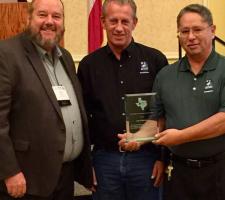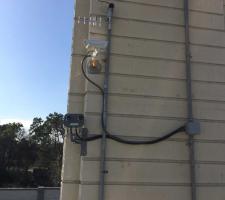
Savings by Texan public agencies are major factors in the recent ITS Texas awards, recognising beneficial initiatives in bridge strike prevention and traffic intersection control. In the first, the
This is saving a minimum of $2m a year by encouraging OHV drivers approaching on interstate highway 10 (I-10), which crosses the conurbation west-to-east, to enter, as an alternative, the I-610 Loop, which intersects I-10 at two points. The Loop marks the effective boundary of the city centre. The innermost of three beltways, it offers a safe - if slightly longer and sometimes more congested – option to the I-10, which has several low-clearance bridges.
In January 2015, following continuing hits on these (including 35 hits in 2014), the city reacted, working through the
Dynamic message
Each unit is integrated with a dedicated dynamic message sign (DMS) that activates whenever the sensor generates an alarm and presents the OHV driver with a single-phase, three-line message: ‘OVERHEIGHT MUST EXIT I-160’. A fixed
The average number of alerts raised is 64 per day on I-10 West and 27 per day on I-10 East. Evaluations carried out in 2015 and 2016 showed increases in trucks using the advised alternative route of 5-7%, while bridge hits reduced by two-thirds - from 35 in 2014 to 12 in both 2015 and 2016.
Several other TxDOT districts have deployed Trigg systems, but none are integrated with cameras and DMS. Pietrzyk explained: “Other OHVDS deployments tend to focus on specific locations. We are intercepting and alerting all OHVs approaching along I-10 and then directing them around the city centre.”
On possible expansions, he added: “Until enforcement can be fully integrated, further deployment is not warranted.” Violation photos are currently archived for analysis and research; using them for enforcement – and, potentially, compensation - will need a change in Texas state law.
The scheme archives are held by the Texas Transportation Institute (TTI), which issues regular status summaries. It contributed to the creation of TranStar, and developed and maintains the software underpinning its central information hub.
Advice and warnings reach the travelling public through the TranStar website, DMS, and subscribers’ mobile phones and email accounts. The website traffic map reaches a million users a month.
Signal success
The second ITS Texas award winner is the city of Baytown, a few minutes’ drive east of Houston. It is a major hub for oil refining, and the chemical, plastics and rubber manufacturing industries, for which its three main north-south traffic corridors - Garth Road, State Highway (SH) 146 and Main Street – are key links.
These have been regularly impacted by the atypical or unpredictable congestion generated by the heavy industrial base. Garth Road, for example (a 6km, five-lane corridor), does not have a normal morning peak. Analysis of intersection traffic counts (now refined by new system controllers) has shown that flows typically continue to build up all morning until after midday, when they break for a couple of hours before resurging to an afternoon peak.
In 2016, the city won a $773,000-plus grant from TxDOT for converting the first two corridors from standard time-of-day (TOD) to adaptive signal timing - a total cost of $967,163, with Baytown paying US$193,433 as a 20% contribution.
The city also paid $260,000, again from its own funds, to upgrade Main Street. The combined funding has secured deployments at 37 signalised intersections along all three corridors. The system runs on a central core of
“Our roadway network is now able to handle its traffic because of the adaptive system,” Baytown traffic engineer Matthew Johnson told ITS International.
Fallback mode
The technology proved its worth when, on 23 May 2017, the new server suffered a nine-hour power outage and corridor management returned to fallback mode, using the earlier TOD programming. Johnson continued: “While this wrought havoc for road users for almost nine hours, it allowed us to analyse and compare the performance of the corridor under both before and after conditions.”
Having pulled the traffic counts for a Garth Road intersection for both 23 May 2017 and 22 May 2018 - and established that flows were virtually identical – the city then pulled the relevant travel time data (see table 1). It found that the new system was working as it should on 22 May 2018, while the TOD alternative had performed badly a year earlier.
Overall travel times are now 55-60% of what they were, reducing road user opportunity cost, greenhouse gas emissions and fuel consumption. (On the first point, using data from the Bureau of Economic Analysis division of the US Department of Commerce, the city was able to put the figure for the nine hours during which the new server was down at $49,883).
The decision to self-install “was not easy”, said Johnson. “But it has paid off, allowing us to save roughly $10,000 per intersection - approximately one third that of the equipment - and develop our own staff.
They now know how the system works, and can fix almost any issue. They have grown in ability and confidence, creating a culture of ownership and decreasing turnover. We hope our work can help other mid-sized US cities.”
ITS Texas president Tony Voigt told ITS International: “These agencies were looking for unique applications to address their problems, and ITS-based solutions were the best fit”.







